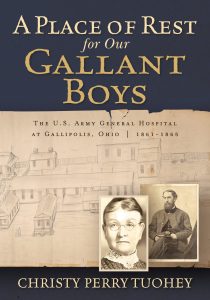Book Review: A Place of Rest for Our Gallant Boys
The mass mobilization of men during the Civil War and the sheer scale of combat and casualties called for serious reconsideration of American medical practice. Just as battlefield medicine and field hospitals were overhauled thanks to the leadership of men like Jonathan Letterman, these improvements followed wounded men as they left the front lines and journeyed to larger, more permanent hospitals across the United States. A Place of Rest for Our Gallant Boys follows the story of one such hospital set up in Gallipolis, Ohio, a small town along the Ohio River bordering what would soon become West Virginia.
This border region of western Virginia saw a lot of maneuvering during the early stages of the war, and while the battles may seem smaller scale, it was vital to have a large hospital, at times supporting hundreds of soldiers, near enough to care for the most severely wounded. Gallipolis General Hospital began by commandeering a local school and evolved into elaborate, long, ridge-ventilated hospital wards. Staffed by army surgeons and nurses like local schoolteacher Hannah Utley Maxon, medical care evolved as knowledge increased both on an individual and national level.
Tuohey clearly put a lot of time and effort into this project. The chapters track the changes at the hospital, often through human interest stories of the doctors, nurses, and soldiers that inhabited the complex. They are touching and must have been difficult to piece together, and the microhistorical analysis of how the war and this hospital affected a small community is admirable. I especially enjoyed the chapter following Hannah Utley Maxon and others into the postwar period. There’s also an impressive number of photos and illustrations, including original plans for the hospital complex and several photos obtained by communication with descendants.
While I liked what I found in the pages of this book, I found myself consistently wanting more; the main text of the book only measures at 94 pages. It hints at fascinating stories of certain individuals, of soldiers sent home on furlough to vote in the 1864 election, and the burial of those who did not survive. What is in the book is great, and I just wish there were deeper dives into certain concepts that only scratched the surface. The selected bibliography shows effort to engage with related sources and briefly examine related secondary literature and scholarship on Civil War medicine. Thought it at times mentions medical innovation in the field or at other hospitals gleaned from the work of other scholars, I would have liked to have seen further comparisons about how Gallipolis was unique or similar or how the personal accounts compared to other surgeons or soldiers grappling with comparable wounds.
The appendices make up about a third of the book, running from pages 95-142. They include a list of surgeons assigned to the hospital, a second list of additional hospital staff, and a third list of nurses that labored there. Following the staff rosters is an appendix of hundreds of United States soldiers recorded at the hospital and a shorter list of the known Confederate soldiers treated there, though the author admits the latter list is incomplete. As someone who has spent countless hours transcribing hundreds of medical records and staff listings from another Civil War general hospital, I am acutely aware of exactly how much effort this must have taken. These appendices and painstaking recordings of the lives of the wounded and those that labored to save them are priceless to regimental historians, local history researchers, and genealogists.
A Place of Rest for Our Gallant Boys may have a niche audience. Still, to that audience the labor of love that is this book is absolutely invaluable.
A Place of Rest for Our Gallant Boys: The U.S. General Hospital at Gallipolis, Ohio, 1861-1865
Christy Perry Tuohey
35th Star Publishing, 2022
$18.95 paperback
Reviewed by Jon Tracey


Thanks for reviewing this book. I’m intrigued by it since a soldier I’ve researched who was wounded in the Lynchburg Campaign ends up at Gallipolis and is rather graphic in some parts of his diary about his treatment and the surgeons. Might be an opportunity to try to put names and details to his short, painful writings.
Sarah, thanks for your comment! I would be happy to share information with you to help you profile that soldier. You are welcome to email me at: christyperrytuohey@gmail.com or message me through Facebook: CP2EAuthor.
Thanks! I appreciate the offer and hope to follow up when I return to that research.